Posted by Anita on 06.21.09 8:31 PM
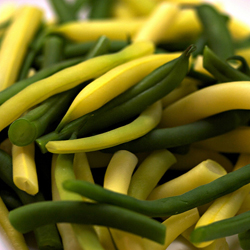 A few weeks ago, we headed down to Los Angeles for a quick getaway. Ostensibly, the occasion was our seventh(!) wedding anniversary, but truthfully the real purpose of our trip was to eat at all the places we’d been adding to our ever-expanding “must-try” list.
A few weeks ago, we headed down to Los Angeles for a quick getaway. Ostensibly, the occasion was our seventh(!) wedding anniversary, but truthfully the real purpose of our trip was to eat at all the places we’d been adding to our ever-expanding “must-try” list.
At the very top of said list was Pizzeria Mozza, the newish joint venture from Mario Batali and Nancy Silverton. After hearing rave reviews from pretty much every newspaper, magazine, blog, and friend, we decided to schedule Mozza in a prime Friday-night slot, to make sure we were getting the A-team of cooks and servers.
I won’t bore you with the litany of every thing that went wrong that night — we’re over the tedious exercise of writing negative restaurant reviews — but here’s the short version: Unexciting food, abysmal service, and pacing so unbelievably rushed that we were back in our car just 29 minutes after our first (and only) glass of wine hit the table. Seriously.
But every cloud has a silver lining. And at Mozza, that lining took the form of a fabulous melange of slender haricots verts, sweet shallots, crunchy hazelnuts, and creamy whole-grain mustard dressing (which, ahem, arrived in place of the roasted-cauliflower dish we’d actually ordered). Amid a menu of fair-to-decent dishes, this small plate stood out, and we quickly realized that we could easily duplicate it at home. We combed through every Batali and Silverton cookbook we own, but found nothing similar. However, Googling “beans + mustard + vinegar + hazelnuts” led us to a likely recipe — not from either of the Mozza chefs, but from Chef Dan Barber of New York’s Blue Hill restaurants.
Although we’re still a few weeks away from finding slim haricots at our market, their larger cousins are already becoming plentiful. And though hazelnuts aren’t grown in the Bay Area, we have plenty of other local options. We opted for walnuts, but made them a little more decadent by rubbing off their skins after toasting them lightly in a pan. After that, the rest of the dish comes together in a matter of a whisk here, a blanch there. And when served with a quick-brined pork chop and the first new potatoes of the year — as we did, for our One Local Summer meal this week — it makes for a great summer side-dish.
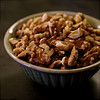

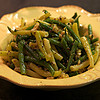
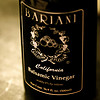
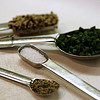
Summer Beans in Grainy Mustard Vinaigrette
— adapted from Dan Barber
1 T finely chopped shallots
2 T balsamic vinegar
12 oz trimmed green and yellow-wax beans (about 4 cups)
1/2 T whole grain mustard
1/4 cup good-quality extra-virgin olive oil
1 T chopped chives
1 T plus 1/4 tsp salt
1/4 tsp freshly ground pepper
2 T blanched nuts (we used walnuts) toasted, peeled if desired, and coarsely chopped
Soak shallots in balsamic vinegar in a small bowl for 30 minutes; set aside for later use.
Fill a saucepan with 2 quarts of water and 1T salt; bring to a boil. Meanwhile, fill a large bowl with water and ice.
When water comes to a boil, add beans and cook until just tender, about 3 minutes. Drain quickly and shock beans in the ice-water bowl. When fully chilled, drain beans well, pat dry, and set aside.
Stir mustard into balsamic-soaked shallots. Gradually whisk in olive oil until blended. (If you’d like a creamier dressing, buzz with a stick blender until well emulsified.) Add the chives, 1/4 teaspoon salt, and pepper; stir until combined.
Toss dressing with beans and nuts until evenly coated; serve immediately.
Farmers and food artisans who created the ingredients for this week’s meal: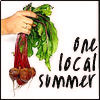 Marin Sun Farms
Marin Sun Farms, Point Reyes: Pork chop
Fox Barrel, Fairfax: Hard cider (for brine)
Eatwell Farm, Dixon: New potatoes
Dirty Girl Produce, Santa Cruz: Shallots
Bariani, Sacramento: Olive oil and balsamic vinegar
Dwelley Farms, Brentwood: Green and wax beans
Boccalone, Oakland: Whole-grain mustard
Glashoff, Fairfield: Walnuts
…and our own
homegrown chives and homemade chicken stock
locavore, One Local Summer, recipes, restaurants, SoCal
12 Comments »




Posted by Anita on 06.13.09 8:34 PM
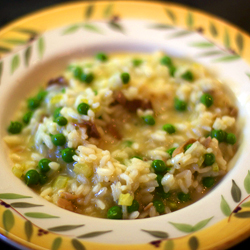 One of the greatest pleasures of growing your own food is standing next to your plot — preferrably while still in your pyjamas — and nibbling on the tenderest first bits of your harvest. I don’t think I’d be exaggerating if I said that Cameron and I probably ate a quarter of our shelling-pea crop in just that way. And even though it cut down dramatically on the number of peas that actually made it to the kitchen, I wouldn’t change a thing.
One of the greatest pleasures of growing your own food is standing next to your plot — preferrably while still in your pyjamas — and nibbling on the tenderest first bits of your harvest. I don’t think I’d be exaggerating if I said that Cameron and I probably ate a quarter of our shelling-pea crop in just that way. And even though it cut down dramatically on the number of peas that actually made it to the kitchen, I wouldn’t change a thing.
For this week’s One Local Summer meal, we enjoyed the last of our pea harvest in one of our favorite recipes, a risotto so deliciously savory that we’ve made it three times already this year. We’ve got another batch of peas already slinking their way up the trellis — courtesy of our mild summers, we get to enjoy spring crops nearly all year long — and already I am counting the days until we can make this simple supper again. Because although it’s fine with the regular farmers-market ingredients, it truly becomes its very best when made with tiny, super-sweet, just-picked baby peas.

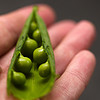

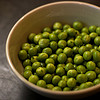
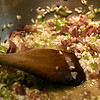
Risi e Bisi (Venetian Style Pea Risotto)
– adapted from Molto Italiano
2T extra-virgin olive oil
1 shallot, chopped
1 celery rib, chopped
1 oz prosciutto, cut into in 1/8-inch dice
3/4 cup Arborio or Carnaroli rice
1 quart chicken stock, warmed
1 cup shelled fresh peas
2T butter
1/4 cup grated hard cheese, such as dry Jack or Parmesan
salt and pepper
Heat the olive oil in a tall-sided 10-inch skillet or saucier pan. Saute the shallots, celery, and prosciutto over medium heat until soft, about 8 minutes. Add the rice and stir for 2 minutes, until the grains become opaque. Add enough stock to just cover the rice, and stir until stock is absorbed. Continue to add stock a ladleful at a time, waiting until most of the liquid is absorbed before adding the next bit. Taste the rice, and season with salt and pepper. Add peas and cook for 4 minutes, until peas are just tender. Remove from heat, add butter and cheese, and stir until just melted. Serve in warmed shallow bowls.
Farmers and food artisans who created the ingredients for this week’s meal: Bariani
Bariani, Sacramento: Olive oil
Dirty Girl Produce, Santa Cruz: Shallots
Catalán Family Farm, Hollister: Celery
Boccalone, Oakland: Proscuitto cotto
Lundberg Family Farms, Richvale: Eco-farmed white Arborio rice
Spring Hill Cheese Company, Petaluma: Butter and Dry Jack cheese…plus our own homemade chicken stock, made from
Marin Sun Farms and
Soul Food Farm chicken bones and our own homegrown English shelling peas
locavore, One Local Summer, recipes
9 Comments »




Posted by Anita on 06.03.09 6:19 PM
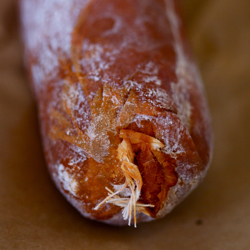 I first read about ‘nduja — a red-hot Italian meat paste that’s pronounced “en-DOO-ya” — in Saveur magazine, ages ago. Despite being the sort of foodstuff that’s right up my alley (hello, chiles and pork… together?!), I never seemed to be able to put my hands on the stuff. We’d heard rumors of a stall at London’s Borough Market selling ‘nduja, but our travels there never seemed to line up with their production. It seemed we’d have to make a trip to Calabria for the real thing, or go without.
I first read about ‘nduja — a red-hot Italian meat paste that’s pronounced “en-DOO-ya” — in Saveur magazine, ages ago. Despite being the sort of foodstuff that’s right up my alley (hello, chiles and pork… together?!), I never seemed to be able to put my hands on the stuff. We’d heard rumors of a stall at London’s Borough Market selling ‘nduja, but our travels there never seemed to line up with their production. It seemed we’d have to make a trip to Calabria for the real thing, or go without.
All that changed last month, with the introduction of locally made ‘nduja from Chris Cosentino’s Boccalone Artisan Meats. This spicy, spreadable salami’s quickly become the darling of the Bay Area carnivores, complete with an adorable nickname and mouth-watering coverage in all the hip spots.
But as delicious as it is when simply spread on a slice of baguette or a cracker, it seemed sacrilegious to snarf down such a long-sough treasure as an appetizer. Searching for other options, I came up with Gina DePalma’s very loose recollection of an ‘nduja-centric pasta dish she whipped up in her Roman kitchen. Despite not being much of a recipe — it lacked both measurements and timing cues — our first attempt at reproducing it turned out incredibly well, if I do say so myself. (You don’t have to take my word for it: Our friend Matthew, a former restaurant critic for the Seattle Times, pronounced it “as good as anything I had in a restaurant” during his visit to San Francisco.)
Now, I’m not sure I’d pick this humble pasta over an evening at SPQR or Contigo, but the dish was far more delicious than the effort it took to whip together. We nearly always have some dried pasta and a frozen container of leftover beans in the freezer; if I just keep a package of ‘nduja around, we’ll never lack a quick, weeknight supper.
The hardest part of the recipe may be getting your hands on the ‘nduja, which isn’t hard at all if you live in or near San Francisco: They sell it at the Boccalone Salumeria at the Ferry Building. For those of you farther afield, there’s always mail order (or a trip to Calabria?). Once you get your hands on the necessary ingredients, free to wing it with the ratios, just as we did. With such flavorful ingredients, I’m sure it’ll be just as good.

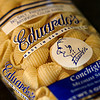
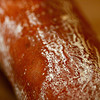

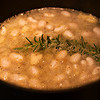
Pasta e Fagioli with ‘Nduja
– adapted from Gina DePalma
1 cup dry white beans
1 small onion, diced
olive oil
1 sprig rosemary
1 bay leaf
salt and pepper, to taste
1 carrot, peeled (if needed) and diced
1 stalk celery, chopped
2 cloves garlic, minced coarsely
4 oz (1/2 chub) cured ‘nduja, broken into chunks
8 oz dry small pasta, such as shells or ditalini
more olive oil, for garnish
hard Italian-style grating cheese, such as Pecorino
Soak the beans in enough water to cover by double their height, overnight if possible. When beans are soaked, heat a medium saucepan over medium-low heat; saute the onion in a good amount of olive oil until soft but not brown. Add the beans, their soaking liquid, rosemary, and bay. Bring to a hard boil for a few minutes, then reduce heat to a gentle simmer and cook until beans are beginning to become tender, but still firm. (This will take anywhere from 45 minutes to 3 hours, depending on the age of your beans and the length of their soaking.) Add the salt and pepper to taste, and simmer for another 10 to 15 minutes. At this point, you can discard the herbs and cool the beans in their liquid for later use.
When ready to bring the dish together: If you’ve made the beans ahead, gently warm them in their liquid in a small saucepan. Cook the pasta, stopping a minute or two before the cooking time on the package; drain and set aside. Meanwhile, heat a large skillet and add 2T olive oil. Saute the carrots and celery until soft; add the garlic and saute another minute. Add the ‘nduja, pressing to break it up and melt it as it heats. Add the beans and a small amount of their cooking liquid to the ‘nduja pan, along with the cooked pasta. If the mixture is dry, add more bean liquid until it’s wet; simmer a few minutes to allow the flavors to come together.
Divide the pasta into two or three warmed bowls. Drizzle with olive oil and top with shredded cheese.

This recipe is our entry for the inaugural week of
One Local Summer 2009, hosted by
Farm to Philly, with Western Region posts graciously recapped by
Columbus Foodie. Just like
last year, we’ll be exploring and honoring the foods from our local farmers and producers with at least one meal each week made from 100% local ingredients. We’re not declaring any exemptions this time — other than salt and spices — and our radius will be 100 miles.
Farmers and food artisans who created the ingredients for this week’s meal:
Iacopi, Half Moon Bay: Italian butter beans
Catalán Family Farm, Hollister: Onions
Bariani, Sacramento: Olive oil
Star Route, Bolinas: Carrots
Chue’s Farm, Fresno: Celery and garlic
Boccalone, Oakland: ‘Nduja
Eduardo’s, San Francisco: Pasta shells
Joe Matos, Santa Rosa: St. George cheese
….plus rosemary and bay leaf from our garden
cooking, locavore, meat, One Local Summer, recipes
11 Comments »




Posted by Cameron on 05.23.09 8:55 PM
 A couple of weeks ago, I ended up talking to a reporter for the SF Chronicle for a story on urban gardening, and had a grand time bending her ear about my recent adventures. But after I rang off, my lovely and talented wife gently reminded me that our own home-grown publication hadn’t seen any garden news in… er… months.
A couple of weeks ago, I ended up talking to a reporter for the SF Chronicle for a story on urban gardening, and had a grand time bending her ear about my recent adventures. But after I rang off, my lovely and talented wife gently reminded me that our own home-grown publication hadn’t seen any garden news in… er… months.
Let’s see… where were we? In mid-January, everything in our newly built beds looked very promising: The radishes had sprouted, the onion sets were sporting little green mohawks, and the peas were “ready to wrestle a very tiny trellis into submission.”
But by mid-February, though the peas were still rocking and rolling, everything else had stopped growing. It was a completely pathetic sight: Rows of tiny green leaves surrounded by what looked like miles of grey-brown wasteland. By mid-March, the peas really did need some kind of trellis, but everything else was basically unchanged. I started to wonder if cold weather and frost had nuked my seedlings. Ridiculous, sure, but what did I know?
That was the start of a spring spent learning how to turn raw dirt and compost into a place where plants actually want to grow. I reconfigured the drip irrigation system three times, then watered by hand. I added more compost, cocoa bean mulch, fish emulsion, greensand, and finally a general purpose organic fertilizer. Basically, I followed the same approach as new parents confronted with a crying baby — “Is it thirsty? Is it hungry?” — except I was getting a lot more sleep.
I replanted the radishes and beets in what I hoped were more hospitable digs (ha!). But my thrill at the quick flush of new growth turned to fury as I realized that the new seedlings were being eaten down to the stem almost as soon as they emerged. As if that weren’t enough, I found that by filling raised beds with soft compost and soil, I had inadvertently opened a five-star refreshment facility for the neighborhood cats.
Imagine the thousand scenes where Clint Eastwood’s eyes narrow to a hard, weatherbeaten squint behind a loaded sixgun, and you’ve got a picture of my state of mind. The words “critter” and “varmint” entered my vocabulary. I closed the kitty spa by installing a low fence around the beds, but that didn’t stop whatever was chewing on the delicate sprouts. I embarked on nightly expeditions armed with a flashlight to try and catch insectile marauders in the act. That was the worst part: I couldn’t find any evidence of what was doing the damage. At last, I spotted a lone earwig scurrying across the beds late one night. Skeptical but desperate, I put out small tins full of beer as traps; after a couple of days, I was happy man. Those little prehistoric-looking summbitches loves them some suds, but they sure can’t swim a lick.
By this point it was April and though the peas were swarming up the second trellis I’d built (they didn’t like the first one — who knew that peas could be divas?), the rest of the plants looked like they’d survived a war. So I did the sensible thing: I planted more stuff that I’d never successfully grown before. Pickling cucumbers and cornichons took up residence in the beds. On the edges of the yard — in the sunniest, warmest spot along our northern fence — I put in St. Pierre and New Girl tomato plants, along with a brace of Kentucky pole beans around the corner. I adapted a yard composter to serve as a potato tower, populating it with seed potatoes that had returned with us from London. And although several of the cucumber plants didn’t thrive, everything else seems reasonably happy and healthy.
Back in November, when I first contemplated pulling up the slate tiles of our beautiful (though completely unused) patio and dropping a bunch of cash on wood, dirt, and compost, I slowed my racing heart by remembering that I had a lot to learn, that the first year of the garden would be a pure lark. Even so, I had no idea how difficult and how rewarding this project would be. On top of finding out basic stuff about what makes plants happy, I’m getting to know our back forty (feet) and its little ecosystem: Where the sun shines and where it doesn’t, what’s in the soil and what isn’t, and what sort of critters and varmints (good and bad) are crawling around.
One of the more amusing revelations that I’ve had along the way is that when it comes to our patch, nobody knows much more than I do. Last week, I decided that I wanted to put asparagus along the eastern fence line, but I was worried that it was too late in the season to plant the crowns. I fired off an e-mail to an expert source and got a response that boiled down to, “Sounds like a great idea! It might work…but then again it might not. Give it a try!” They say that in politics that if you want a friend, you should get a dog. In gardening, if you want certainty, get FedEx or get religion.
But the lack of guarantees may be what makes the harvest so special and satisfying. I still can’t quite believe it when I see the (very small) piles of radishes on the counter that went from seed to salad not thirty feet from the kitchen sink. I’ve got a long way to go, but the path ahead is one of the most inviting that I’ve ever seen. Every single peapod I munch tastes like victory.





garden
14 Comments »




Posted by Anita on 05.14.09 6:26 AM
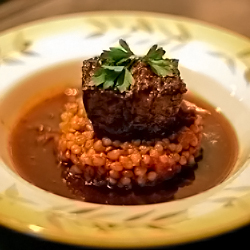 Despite our enduring love for our nieces and pint-sized friends, this blog will never feature the sort of recipes that usually pass for kid-friendly meals. With high-octane cocktails, labor-intensive recipes, and frequent bouts of profanity, no sane reader would ever mistake me for a mommy blogger. And yet, one of the best food books I’ve read in quite some time — one I actually forked over cash to buy — is Hungry Monkey: A Food-Loving Father’s Quest to Raise an Adventurous Eater. A title that’s shelved not with the cookbooks, but in the heretofore unexplored Baby & Toddler section of my local bookstore.
Despite our enduring love for our nieces and pint-sized friends, this blog will never feature the sort of recipes that usually pass for kid-friendly meals. With high-octane cocktails, labor-intensive recipes, and frequent bouts of profanity, no sane reader would ever mistake me for a mommy blogger. And yet, one of the best food books I’ve read in quite some time — one I actually forked over cash to buy — is Hungry Monkey: A Food-Loving Father’s Quest to Raise an Adventurous Eater. A title that’s shelved not with the cookbooks, but in the heretofore unexplored Baby & Toddler section of my local bookstore.
I doubt Hungry Monkey would have found its way to our house if we weren’t already friends with the book’s author, Matthew Amster-Burton, and his daughter Iris. But that surely would have been my loss, because once I picked it up, I couldn’t stop reading. Or laughing. Matthew’s a pretty funny guy, something you may already know if you read his blog, Roots & Grubs, or his witty writings on Culinate, Gourmet.com, or pretty much anywhere else you go for clever, thoughtful food writing these days. And even if you couldn’t give a fig for the intricacies of raising a little fresser, you can’t help but be drawn in by Matthew’s no-nonsense ideas about food.
Now, in the interest of full disclosure, I think it’s only fair to admit that I’m friends not only with Matthew, his wife Laurie, and little Iris, but also with grandma Judy, and many of the other characters in the book — Tea, Shauna, Molly, and the gang — so reading a chapter is like old home week for me. Some of my favorite memories from our Seattle days involve the dinner parties we used to throw. Every New Year’s Day, we’d make an enormous pot of cassoulet and invite our friends to polish it off; the Amster-Burtons were among the 50 or so food-obsessed friends who came to the second-annual fête.
I don’t remember much else from that day, but I do remember Iris — who had just turned one — sitting on our kitchen floor and calmly polishing off an adult-sized plate of braised pork, beans, and duck confit. Reading the book, I was tickled that Matthew remembered, too: The cassoulet-gobbling tale is but one of dozens of spot-on anecdotes he uses to illustrate his theories. (In this case, the point is: “Stew is the ultimate in baby food. It’s easy to make. It’s easy to eat: you don’t even need teeth.”)
But aside from personal affection, Matthew’s stories of cooking for Iris are universal, whether you’re a parent, a proud aunt, or even kid-agnostic. In a way, my feelings about Hungry Monkey are similar to Matthew’s own enthusiasm for his daughter’s culinary education:
“I was gung-ho about sharing our food with Iris for the same reason people share food with each other everywhere: it’s fun. It was the first opportunity for Iris and me to share an experience and enjoy it for the same reasons. I mean, I liked playing peek-a-boo (I called it “peekytoe”) because it made Iris laugh, but it’s not like it’s something Laurie and I played before Iris was born — or, at least, I wouldn’t admit to it. But I like enchiladas. Iris likes enchiladas. We can agree on enchiladas.”
On the surface, I may not have a lot in common with a stay-at-home dad. But our mutual love of food — and a fondness for belly laughs — makes Hungry Monkey worth a read, even if you have no experience with the tribulations of breastfeeding, or coaxing a toddler to the dinner table. With the exception of a couple of purees, there’s hardly a recipe in the book that looks or tastes like kid chow. Last winter, Cameron and I tested a dozen or so of the recipes during the book’s development, and we’ll personally vouch for Matthew’s stacked enchiladas, Cornish pasties, and bibimbap, not to mention a recipe for carnitas that’s so quick and simple we didn’t believe it would work. (It did, deliciously.)
If you need further convincing, plan to pop by one of Matthew’s readings in the Bay Area the week of May 24 (check the schedule here). Photographic evidence indicates that Hungry Monkey is even more hilarious when read aloud by its author.
If you can’t get to one of Matthew’s book-signings, there’s still a chance to have your own brush with fame: I’ve got an extra copy of the book — there is some payoff for being a recipe-tester! — and it just so happens that Matthew will be visiting us on his swing through town. So, if you’d like to win an autographed copy of Hungry Monkey, leave a comment below telling us about your favorite food when you were little. Next weekend, I’ll pick a comment at random and get in touch with the lucky winner to ask how they’d like the book inscribed.
In the meantime, here’s a little proof that not all kid-friendly food has to look like stewed prunes and taste like mush.
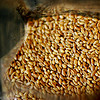
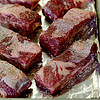
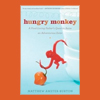
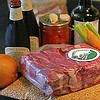
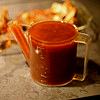
Beer-Braised Short Ribs with Wheat Berries
– from Hungry Monkey by Matthew Amster-Burton, reprinted with permission
3 to 4 pounds beef short ribs (flanken or English-style)
salt and pepper
3 tablespoons olive oil
2 cloves garlic, thinly sliced
1 large onion, diced
1 carrot, peeled and diced
1 celery stalk, diced
1 cup wheat berries (see note)
2 bottles (2-1/4 cups) porter-style beer
1 cup canned crushed tomatoes, not drained
1-1/2 cups chicken stock
2 tablespoons minced parsley
Preheat oven to 450°F.
Season the ribs liberally with salt and pepper and place them on a foil-lined baking sheet (bone-side down if you’re using English style ribs). Roast 45 minutes or until they’re nicely browned and have rendered plenty of fat. Reduce oven temperature to 275°F.
While the ribs are roasting, heat the olive oil in a Dutch oven or other large pot over medium heat. Add the garlic, onion, carrot, and celery. Cook until vegetables are limp but not browned, 5 to 10 minutes.
Add the wheat berries, beer, tomatoes, and chicken stock, and stir to mix. Add the browned ribs, raise the heat to medium-high, and cover. When the pot is boiling, transfer it to the oven (you did remember to turn it down to 275°F, right?). Braise for 2-1/2 to 3 hours, or until meat is very tender. Season with additional salt and pepper to taste.
If serving immediately, remove the meat and strain the sauce, then skim off the fat with a spoon or gravy separator. Otherwise, cool to room temperature and refrigerate everything together, skimming off the solidified fat before reheating. Give each person one or two ribs (remove the bones before serving if you like), a ladleful of wheat berries and sauce, and a sprinkling of parsley.
Note: Wheat berries are available in the bulk section at any health food store. Mine has sometimes managed to run out, so I’ve substituted pearl barley to good effect. Hard or soft wheat berries will work. For another variation, substitute French green lentils for the wheat berries.
cookbooks, meat, other blogs, recipes
26 Comments »




Posted by Anita on 05.12.09 5:34 PM
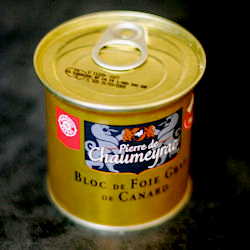 Bill Andronico
Bill Andronico
Andronico’s Markets Inc.
1109 Washington Avenue
Albany, CA 94706
Dear Mr. Andronico:
I have been a long-time shopper at your Irving Street store in San Francisco. Although I no longer purchase meat at the supermarket — preferring to buy my meat and eggs directly from farmers who make a point of their humane and ethical practices — I have always been very impressed by the knowledge and skill of your butchers in the past. Which is why I am stunned to read about your ill-informed, reactive policy regarding foie gras sales.
I don’t generally eat foie gras myself — I don’t care for its richness, nor its cost — but from rather extensive reading on the subject, I think it’s quite plausible that the “cruelty” of its production is overrated. On the other hand, I fully believe that standard, everyday conditions for commercial hens, pigs, cows, and other factory-farmed animals are grossly inhumane by any realistic measure.
If you and your company truly cared about animal welfare, you would stop selling battery-hen eggs and feedlot pork. Intensive factory farming is far more cruel — and thousands of times more pervasive — than the process of “force feeding” geese and ducks.
I suggest you do some additional homework about the realities of what goes into the meat, eggs, and dairy you sell before zeroing in on such an easy knee-jerk target. (The movie Food, Inc., which opens next month, might be a good starting point.) Otherwise, you run the risk of looking like a publicity-hungry hypocrite.
Bay Area, meat, shopping
9 Comments »




Posted by Anita on 05.11.09 7:18 PM
 It’s hard to believe that in just two months — July 8 through 12 — we’ll be back in New Orleans for this year’s Tales of the Cocktail. Cameron and I are both participating in this year’s TalesBlog group, and {gulp} I’m moderating a Saturday-morning seminar called “Secrets of Cocktail Photography“.
It’s hard to believe that in just two months — July 8 through 12 — we’ll be back in New Orleans for this year’s Tales of the Cocktail. Cameron and I are both participating in this year’s TalesBlog group, and {gulp} I’m moderating a Saturday-morning seminar called “Secrets of Cocktail Photography“.
TalesBlog is already up and running with previews of many of the interesting sessions, tasting rooms, events, and meals that make Tales the must-do event for anyone who loves cocktails. The contributor list is pretty much a Who’s Who of top cocktail bloggers, so it’s worth adding to your feed-reader even if you’re not planning to attend.
In other Tales-related news, host venue Hotel Monteleone is celebrating the 60th anniversary of the Carousel Bar, and they’re celebrating with a contest open to all bloggers. Here’s the gist: From 1949 until sometime in the late 60s or 70s there was a drink on the Carousel Bar’s menu called the Monteleone Cocktail. Unfortunately, the hotel folks have no idea what the exact recipe or ingredients were.
Here’s where you come in: Submit a recipe for your best idea for the new official Monteleone Cocktail. Entries will be judged by VIPs at the Carousel anniversary celebration on May 21. There are no requirements on types of liquor or style of drink, but all entries must be posted on your blog and emailed to the sponsors no later than May 18. (Send your drink recipe, along with your name, address, and phone number, to athornton@hotelmonteleone.com.)
The winning entry will become the new official Monteleone Cocktail, and the winner will receive four free nights at Hotel Monteleone during Tales of the Cocktail 2009.
bar culture, drinks, New Orleans, Tales of the Cocktail, travel
5 Comments »




Posted by Anita on 05.01.09 8:14 AM
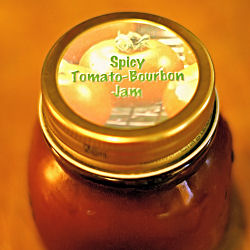 Thanks to Sandy Gluck from Martha Stewart Living Radio‘s Everyday Food. She gave her listeners a shout-out to our Tomato-Bourbon Jam. We use it as a homemade replacement for ketchup, or as the secret ingredient in wintertime BLTs.
Thanks to Sandy Gluck from Martha Stewart Living Radio‘s Everyday Food. She gave her listeners a shout-out to our Tomato-Bourbon Jam. We use it as a homemade replacement for ketchup, or as the secret ingredient in wintertime BLTs.
It’s still a little early for tomatoes, but if you’ve got hothouse tomatoes at your farmers market, as we do, this is one place where they do pretty well.
preserving & infusing
5 Comments »




Posted by Anita on 04.22.09 4:00 PM
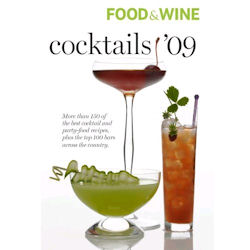 For the food-obsessed, there are a lot of exciting things that pop up in the spring. The first tender favas, skinny spears of asparagus, and fruit-tree blossoms that promise a sweet summer ahead. But in our circle of friends, there’s been another anticipation afoot: The long wait for the new edition of Food & Wine’s Cocktails annual.
For the food-obsessed, there are a lot of exciting things that pop up in the spring. The first tender favas, skinny spears of asparagus, and fruit-tree blossoms that promise a sweet summer ahead. But in our circle of friends, there’s been another anticipation afoot: The long wait for the new edition of Food & Wine’s Cocktails annual.
You may recall our “Book Club” making visits to Range, Forbidden Island, and Bar Drake last year; in fact, our crew managed to hit every San Francisco bar listed in the 2008 edition, sampling a few gems amid a stunning number of failures. (Not to mention the many AWOL contenders; I wish we had a dollar for every time we heard “Oh, that? Nobody liked it, so we took it off the menu.” Sigh.)
When I crossed paths with the book’s compiler, Jim Meehan, at his NY speakeasy PDT, I gave him a fair bit of good-natured grief for our trouble. He allowed that the fleeting nature of drink recipes could be a bit of a problem, but assured me that big changes were in store for 2009, and seemed confident we would like the new direction he’d taken.
It’s still the same book — digest sized, with a clean and colorful layout. But in the biggest change from previous years, where chapters were organized by base spirit, this year’s book focuses on themed chapters: aperitifs, Latin drinks, seasonal drinks, frozen drinks, pitcher drinks, after-dinner drinks, classics, mixologists’ drinks, and mocktails. Each section has a patron bartender, who is briefly profiled and provides all the recipes. Bar celebrities like Jamie Boudreau, Julie Reiner, and (the book’s co-editor) Joaquin Simo take their turns, as do lesser-known mixmasters such as Jeff Grdinich.
The mixologists’ section is like a miniature version of previous editions of the book, a compilation of 18 drinks from top bartenders across the country. Although it’s hard to tell without actually mixing them, the drink recipes from San Francisco shakers — Absinthe’s Jonny Raglin, Neyah White of Nopa, and Jacques Bezuidenhout of Bar Drake — look great on paper. But better still, they come from bartenders who we know understand what works, not just in a highly controlled test-kitchen environment, but in everyday drink-slinging bars. It’s no surprise that some of the cocktails we liked best from last year’s Book Club came from these gentlemen; I can’t wait to give their recipes a test drive.
As before, there’s a directory of top bars listed in the back. This time, the list is explicitly titled “Top 100 Bars”, though they are not necessarily correlated to the included recipes. Frustratingly, other than hat-tips to chapter hosts, there’s no cross-reference to each establishment’s recipes by page number, a detail from past editions I will definitely miss. Cantina’s blurb, for example, mentions Duggan McDonnell by name, offering that “Many of his creations are featured in the Pitcher Drinks chapter (p. 94).” But Absinthe’s listing neither mentions Jonny Raglin, nor directs readers to his recipe on page 135, opting instead for a quizzical mention of Top Cheftestant Jamie Lauren.
As far as the local bars in the Top 100, there’s only a couple of quibbles. Everyone I’ve asked is surprised by the omission of Oakland’s lovely Flora, and it’s odd that Bar Drake didn’t make the cut this year when Jacques’ recipe did. Bix, however, is a total head-scratcher. Despite reviving the classic-cocktail genre a full decade before almost anyone else in town, this stalwart has long been eclipsed in both technical merit and outright hospitality.
The visuals, always a strength of this series, continue to impress. In addition to ace prop styling and eye-popping photography found in previous editions, this year’s version includes more infographics, which should help users navigate now that the book is not organized by spirit type. Graphics show ease of construction and base spirit, in addition to the glassware icon of the past editions. The front matter is perhaps a bit basic for experienced bar aficionados, although there is some good stuff about ice, must-have spirits, and best brands taste-test winners.
Do you need Food & Wine Cocktails ’09 in your bar library? Probably not. But at $10, it’s less than the price of a drink at nearly any of the places it trumpets, and it’s bound to be a fun souvenir of the way we’re drinking in the late aughts.
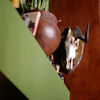



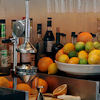
Bay Area bars/restaurants in the Top 100
There are 13 of them this year, which — for those of you keeping score at home — is more than any other city except NYC (home to 14). Mixologists mentioned by name in their establishment’s blurb are shown in brackets.
– Absinthe
– Alembic
– Beretta [Thad Vogler]
– Bix
– Bourbon & Branch
– Cantina [Duggan McDonnell]
– Clock Bar
– Elixir [H Ehrmann]
– Forbidden Island
– Heaven’s Dog [Erik Adkins]
– Nopa [Neyah White]
– Range
– Slanted Door
San Francisco cocktail recipes in the Mixologists’ Drinks chapter:
– Jonny Raglin, Absinthe
Villa Flores: jalapeno, tequila, egg white, grapefruit, agave, orange-flower water, Sichuan pepper garnish
– Neyah White, Nopa
Cherry Samba: cachaca, cherry Heering, Islay Scotch, lemon, simple, egg white
– Jacques Bezuidenhout, Bar Drake
Black Friar’s Pint: gin, cardamom-cinnamon Guinness, sherry, bitters, agave, egg white, cinnamon garnish
San Francisco recipes for Party Food:
– Warm Marinated Olives, Seasons Bar & Lounge
– Queso Fundido, Tres Agaves
– Polpette in Spicy Tomato Sauce, Beretta
And one San Francisco chapter host: Duggan McDonnell of Cantina
bar culture, Bay Area, books & media, drinks, restaurants
6 Comments »




Posted by Anita on 03.16.09 8:45 PM
 Daylight Saving Time arrived this week, and with the longer days come the final few nights of the Dark Days Challenge. We’re also deep into the second full week of our “no new meat” freezer clean-out plan, which is going remarkably well.
Daylight Saving Time arrived this week, and with the longer days come the final few nights of the Dark Days Challenge. We’re also deep into the second full week of our “no new meat” freezer clean-out plan, which is going remarkably well.
Work’s been keeping us both insanely busy, so it’s a treat to be able to eat a home-cooked meal even on the nights when we don’t make it home until well after dark. And, as a side benefit, we’re finally able to see our freezer shelves again.
This week’s dinners included successful renditions of cassoulet, spaghetti and meatballs, and posole verde. But lest you think it’s been an endless buffet of effortless delights, I’ll admit that one night’s dinner — reputedly lasagne — resembled nothing more than a watery bowl of soggy, sausage-flecked dough. (Not sure what happened there; baked pasta always freezes well… or at least always has in the past.) It didn’t taste bad, but it certainly doesn’t count as one of the successes.
As nice as it is to work our way down the freezer inventory and pull a ready-to-heat meal out of storage, it does feel a little anticlimactic. After a few days of thaw-and-reheat, I begin to miss the prep, not to mention the actual cooking. Happily, most of the stuff in the freezer is bits and pieces, not entire prepared dishes, which means that there are plenty of chances to create a dish out of old leftovers or combine assorted remnants with a fresh ingredients to make a dinner that’s more than the sum of its parts.
 Our favorite meal this week: A simple paella that used up some orphaned chorizo, leftover roast chicken, and red pepper strips we froze last summer. It’s not the most authentic Spanish dish, but it’s easy enough to get on the table for a midweek meal, and undeniably delicious. And, as an added bonus, we got to sample the season’s first fava beans — a little dash of spring in our final Dark Days meal. With the exception of the pimentón and the saffron, everything came from within our 100-mile radius.
Our favorite meal this week: A simple paella that used up some orphaned chorizo, leftover roast chicken, and red pepper strips we froze last summer. It’s not the most authentic Spanish dish, but it’s easy enough to get on the table for a midweek meal, and undeniably delicious. And, as an added bonus, we got to sample the season’s first fava beans — a little dash of spring in our final Dark Days meal. With the exception of the pimentón and the saffron, everything came from within our 100-mile radius.
When it comes to paella, the sausage you want is firm Spanish chorizo — the refrigerated sort that’s a similar texture to andouille, definitely not the soft Mexican kind, nor the dry charcuterie style. The Spanish Table in Berkeley sells an assortment of brands; we used the locally made Neto’s.
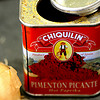



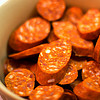
Weeknight Paella
– makes 6 to 8 servings
1 tablespoon vegetable oil
1 pound Spanish chorizo, cut into 1/2 inch slices on the diagonal
1 small onion, chopped
1 red bell pepper, chopped or 1/2 cup bottled red-pepper strips
2 cloves garlic, chopped
1/2 teaspoon pimentón, or to taste
2 cups short-grain rice
1 pinch saffron threads
2 bay leaves
4 cups chicken stock
8oz roast chicken, skinned, deboned, and torn into chunks
1/2 cup peas or shelled fava beans
Salt and freshly ground black pepper, to taste
Heat oven to 400°F.
Heat oil in a very large skillet (ours is 14″) or paella pan over high heat. Add chorizo and cook until browned and fragrant. Drain off most of the chorizo fat, leaving just enough to saute the vegetables. Add onion, red bell pepper, and garlic. Cook, stirring occasionally, until vegetables are tender, about 3 minutes.
Add rice, pimentón, saffron, and bay leaves. Stir to combine and coat the rice, about 1 minute. Add chicken stock and bring to a boil. Add chicken, peas (or favas); stir to combine.
Transfer skillet to oven. Cook uncovered until rice is tender and no liquid remains, about 20 minutes. Remove from the oven. Fluff with a fork and serve immediately.
Dark Days challenge, locavore, recipes
15 Comments »




 A few weeks ago, we headed down to Los Angeles for a quick getaway. Ostensibly, the occasion was our seventh(!) wedding anniversary, but truthfully the real purpose of our trip was to eat at all the places we’d been adding to our ever-expanding “must-try” list.
A few weeks ago, we headed down to Los Angeles for a quick getaway. Ostensibly, the occasion was our seventh(!) wedding anniversary, but truthfully the real purpose of our trip was to eat at all the places we’d been adding to our ever-expanding “must-try” list.

































 Bill Andronico
Bill Andronico It’s hard to believe that in just two months — July 8 through 12 — we’ll be back in New Orleans for this year’s
It’s hard to believe that in just two months — July 8 through 12 — we’ll be back in New Orleans for this year’s  Thanks to Sandy Gluck from
Thanks to Sandy Gluck from 












